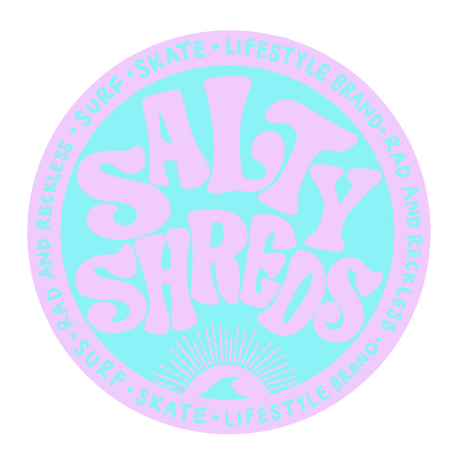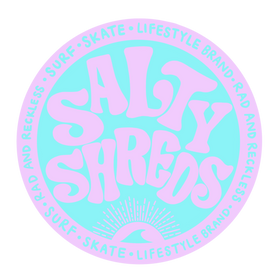Follow Salty Talk for More Radical Reads!
Surfboard 101: The Parts of a Surfboard
The more you know about surfboards, the more you'll fine-tune your equipment throughout your surfing journey. Doing so allows for the highest level of advancement in your abilities and skill sets, as your board makes all the difference.
With this, understanding the parts of a surfboard is a critical component of surfboard 101 and learning how to surf, as these suckers are quite intricate water crafts.
The personality of your surfboard dictates everything, from the size of the waves it can handle to how it performs in specific conditions and what can be accomplished on the waves. And the surfboard parts are all the little things that culminate into this primary personality. Here's exactly what those parts are and why they matter so darn much.
Your Guide to Surfboard Parts
Snag a notepad and your surf groms. It's time for a lesson on the various parts of a surfboard!
A: The Nose
The nose is the frontmost tip of your surfboard. Your surfboard's nose plays a role in the type of board and its resulting performance.
High-performance surfboards are typically shaped with a pointed nose, whereas small wave surfboards, fun shapes, and longboards feature more rounded noses.
If you're looking for a kids' surfboard, one with a rounded nose is ideal!
Rounder noses increase surfboard volume, therefore enhancing the board's buoyancy and wave-catching ability, and a rounded nose is critical for noseriding on longboards.
Pointed noses of performance shortboards allow for an increase in the board's rocker (the vertical curvature of the bottom of the board) to drop into steep waves, the hydro and aerodynamic design allowing for progressive maneuvers on/off the face.
B: The Deck
The deck of your surfboard refers to the entire top portion of the surfboard.
The deck is where you lay on the board while paddling, and it's where you plant your feet after you pop up on the surfboard.
You need to wax the deck of your surfboard to provide traction to your feet.
Surfers often place a traction pad on the tail of the board for even more grip to the back foot when pressing hard over the fins during turns.
Thats the black thing you see on the tail, although in all honestly, this one is placed a little too high up!
C: The Tail
Speaking of the tail, this is one of the most intricate parts of a surfboard that hugely affects the performance. The tail is the back end of your board, and the shape of your tail is a leading factor in how it rides and the type of board. So much so, in fact, that the type of tail often summarizes a surfboard itself.
For example, you'll commonly hear a board referred to as a 'pintail' or a 'squartail', and that's referencing the style of the tail. You could write a book on the intricacies of tail shapes, so let's just keep it simple by saying that wider tails help the board float better while promoting stability on the wave, whereas thinner tail shapes enhance performance.
The tail will also determine how the water moves off the back of the board, creating unique pivot points. A squaretail, for example, has two distinct points where the water will release, which is great for high-performance turns. A pintail will create a singular point of water release, excellent for promoting control in barrels.
Tails feature various rockers, just like the nose, as a more definitive tail rocker improves lift and maneuverability.
Right underneath your board's tail is where you'll find one of the most technologically advanced and diverse parts of a surfboard: the fins.
D: The Surfboard Rails
The rails of your surfboard refer to the sides of your board, its outline, and its edges. The way your rails are shaped hugely influences its ride.
Thick, soft rails are indicative of volume and float, great for stability and catching small waves.
Thick rails are common on hybrids, fun shapes, and longboards and will feature a more rounded shape.
Thin, hard rails are known for performance, as they can carve into the water for big on-rail turns. You'll see hard rails on performance shortboards featuring more angled edges.
The 'sharpness' of the rails allows surfers to dig them into the water hard while maintaining control for big hacks.
E: The Surfboard Fins
Without your fins, your surfboard would have no control, spinning freely on top of the face. By protruding into the water, fins essentially 'grab' onto the wave's power source, keeping the board stable and secured in the wave (preventing uncontrolled spinning) while increasing drive and speed down the line.
The fins allow surfers to turn their boards with intention, the key reason we see such progressive and aggressive turns and airs synonymous with modern surfing.
Boards are shaped to feature anywhere between one to five fins, these setups are known as:
- Single Fin: 1 Fin in the middle of the surfboard
- Twin Fins: 2 Larger fins on each side of the board
- Thruster: 3 fins, two on each side and one in the middle
- Quad: 4 fins, two placed underneath one another on each side of the board.
- Five-Fin: You don't actually surf with five fins. A five-fin set up means that the surfboard can accommodate any version of the prior listed setups, allowing you to switch out the fins depending on preference and conditions.
F: The Fin Boxes
Before placing your fins into the surfboard, you'll notice a few open slots under the tail on the bottom of the board. These slots are known as your fin boxes, and they're the areas where you'll insert your fins into the board.
There are three main types of fin boxes:
- FCS
- FCS II
- Futures
You want to make sure you choose the right fin depending on which box has been shaped into your surfboard. You can't put an FCS II fin in an FCS box, but you can put an old FCS fin in a new FCS II box with the right attachment.
Futures fins do not work in FCS boxes and vice versa.
The only types of surfboards that do not have a fin box are those with glassed-on fins, which are permanently shaped into the board.
G: The Leash
Your leash is an essential surfboard part that must be manually attached to your board. Also known as a leg rope, the leash keeps your board secured to your body in the water. Aka, your leg rope is your lifeline, and it keeps other surfers safe from a wandering board when you bail.
We just went over the surfboard leash parts and how to size your surfboard leash accordingly, so check it out for all the insight. You attach your leash to your board via the leash plug and leash tie
H: The Leash Plug
On the deck of your surfboard towards the end of the tail, you'll notice a small hole with a metal bar extending horizontally through it. This surfboard part is known as the leash plug, and it's where you'll loop your leash tie. The leash tie allows you to attach your surfboard leash to the board and then your ankle to keep it secured to your body when surfing.
I: The Bottom of Your Board
The bottom portion of your board is what will remain in contact with the water while you ride. With this, they are shaped with various channels, contours, convexes, and curvatures that affect water flow and performance.
Unlike snowboards, you don't wax the bottom of your board!
J: The Stringer
Although some epoxy surfboards are now so strong they no longer need a stringer, stringers are still a standard part of a polyester (PU) surfboard. If you notice a small wooden strip running vertically down the center of your board, that's the stringer, and it helps to increase the board's strength, preventing breakage.
K: Other Surfboard Accessories
That about does it for all the parts of a surfboard and what they do. In addition to these parts, you'll discover a plethora of additional surfing accessories that enhance the surfing experience. So check out your board and identify these parts, keep expanding that surfing knowledge, and most importantly: get out there and surf!
Hello to all my salty people! Thanks for readin' my blog and for the continuous support towards our brand. Make sure to sign up to our newsletter by creating your account to stay in the loop with new releases, sales & giveaways, and all our future blog post!
Live rad, stay salty.
- Ash, Dev & The Salty Shreds Fam.

